Gentiloni Cabinet
The Gentiloni Cabinet was the 64th cabinet of the Italian Republic, in office from 12 December 2016 to 1 June 2018. The government was headed by Paolo Gentiloni, former Minister of Foreign Affairs of the Renzi Cabinet.[1]
| Gentiloni Cabinet | |
|---|---|
64th Cabinet of Italy | |
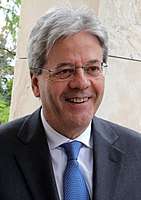 | |
| Date formed | 12 December 2016 |
| Date dissolved | 1 June 2018 (537 days) |
| People and organisations | |
| Head of state | Sergio Mattarella |
| Head of government | Paolo Gentiloni |
| No. of ministers | 19 (incl. Prime Minister) |
| Member parties | PD, AP, CpE |
| Status in legislature | Centre-left coalition |
| Opposition parties | M5S, FI, LN, SI, FdI, UdC, ALA (until Oct. 2017), MDP (since Oct. 2017) |
| History | |
| Outgoing election | 2018 election |
| Legislature term(s) | XVII Legislature (2013–2018) |
| Predecessor | Renzi Cabinet |
| Successor | Conte I Cabinet |
The cabinet was formed after Matteo Renzi's resignation as Prime Minister, due to the result of the 2016 constitutional referendum. The new cabinet preserved most of the ministers of the former Renzi cabinet.[2] It was led by the centre-left Democratic Party (PD), and it originally included the New Centre-Right (NCD) and the Centrists for Europe (CpE) as junior partners. It also included a few non-party independents. The NCD was later merged into Popular Alternative (AP).
History
Background and formation
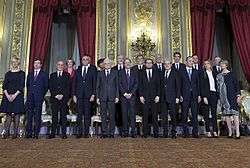
On 7 December 2016, Prime Minister Matteo Renzi announced his resignation, following the rejection of his proposals to overhaul the Senate in the 2016 constitutional referendum. A few days later, on 11 December 2016, President Sergio Mattarella asked Paolo Gentiloni, then Minister of Foreign Affairs, to form a new government.[3][3] On the following day Gentiloni was officially sworn in as the new head of the government.[4]
Gentiloni formed a coalition government supported by his own Democratic Party, the New Centre-Right and the Centrists for Italy. This was the same majority which supported Renzi's government for almost three years.[5] The centrist Liberal Popular Alliance, led by Denis Verdini, did not support the new cabinet, because no party member was appointed minister.[6] Deputy ministers of the Italian Socialist Party and Solidary Democracy were also appointed. After the split of the Democratic and Progressive Movement from the Democratic Party, that party was presented by one deputy minister in the government until 3 October 2017.
Investiture votes
Investiture votes for Gentiloni Cabinet | |||
|---|---|---|---|
| House of Parliament | Vote | Parties | Votes |
| Chamber of Deputies[7] (Voting: 473[lower-alpha 1] of 629, Majority: 237) |
PD (296), AP–NCD (25), CeI (12), Demo.S–CD (12), Others (23) | 368 / 473 | |
| FI (43), SI (28), FdI (8), CeI (1), Others (25) | 105 / 473 | ||
| Abstention | None | 0 / 473 | |
| Senate of the Republic[8] (Voting: 268[lower-alpha 2] of 320, Majority: 135) |
PD (111), AP–NCD (28), PSI–SVP–MAIE (16), GAL–UDC (3), Others (11) | 169 / 268 | |
| FI (38), M5S (31), CR (9), GAL–UDC (7), ALA (1), MAIE (1), Others (12) | 99 / 268 | ||
| Abstention | None | 0 / 268 | |
- Absent (142): M5S (86), Lega (17), NcI–SC–MAIE (13), FI (6), CeI (4), PD (3), FdI (2), SI–SEL–P (2), AP–CpE–NCD (1), Demo.S–CD (1), Others (7)
On institutional leave (14): M5S (5), NcI–SC–MAIE (3), Lega (2), PD (2), FI(1), Others (1) - Absent (44): ALA (17), Lega (9), M5S (4), GAL–UDC (4), FI (3), AP–CpE–NCD (1), CR (1), Others (5)
On institutional leave (7): Lega (3), Aut (2), FI (1), PD (1)
President (1)
Party breakdown
Beginning of term
Ministers
13 | |
3 | |
1 | |
2 |
Ministers and other members
- Democratic Party (PD): Prime minister, 12 ministers, 3 deputy ministers, 16 undersecretaries
- New Centre-Right (NCD): 3 ministers, 1 deputy minister, 10 undersecretaries
- Centrists for Europe (CpE): 1 minister
- Solidary Democracy (Demo.S): 2 deputy ministers
- Italian Socialist Party (PSI): 1 deputy minister
- Democratic Centre (CD): 1 undersecretary
- Civics and Innovators (CI): 1 undersecretary
- Independents: 2 ministers, 4 undersecretaries
End of term
Ministers
14 | |
2 | |
1 |
Ministers and other members
- Democratic Party (PD): Prime minister, 13 ministers, 2 deputy ministers, 16 undersecretaries
- Popular Alternative (AP): 2 ministers, 1 deputy minister, 8 undersecretaries
- Centrists for Europe (CpE): 1 minister
- Solidary Democracy (DemoS): 2 deputy ministers
- Italian Socialist Party (PSI): 1 deputy minister
- Independents: 3 undersecretaries
- Democratic Centre (CD): 1 undersecretary
- Civics and Innovators (CI): 1 undersecretary
- Forza Europa (FE): 1 undersecretary
Geographical breakdown
Beginning of term
- Northern Italy: 9 ministers
- Emilia-Romagna: 4 ministers
- Lombardy: 2 ministers
- Liguria: 2 ministers
- Piedmont: 1 minister
- Central Italy: 7 ministers (incl. Gentiloni)
- Southern and Insular Italy: 3 ministers
End of term
- Northern Italy: 7 ministers
- Emilia-Romagna: 4 ministers
- Liguria: 2 ministers
- Lombardy: 1 minister
- Central Italy: 7 ministers (incl. Gentiloni)
- Southern and Insular Italy: 3 ministers
Council of Ministers
Composition of the Government
| Portrait | Office | Name | Term | Party | Deputy Ministers Undersecretaries | |
|---|---|---|---|---|---|---|
 |
Undersecretaries: Maria Elena Boschi (PD)[lower-alpha 1] Sandro Gozi (PD)[lower-alpha 2] Sesa Amici (PD)[lower-alpha 3] Luciano Pizzetti (PD)[lower-alpha 4] Angelo Rughetti (PD)[lower-alpha 5] (since 26 July 2017) Paola De Micheli (PD)[lower-alpha 6] (since 23 Sep. 2017) | |||||
 |
Before 18 March 2017: New Centre-Right |
Deputy Ministers: Mario Giro (DemoS) Undersecretaries: Vincenzo Amendola (PD) Benedetto Della Vedova (FE) | ||||
 |
Deputy Ministers: Filippo Bubbico (MDP)[lower-alpha 7] (until 9 Nov. 2017) Undersecretaries: Gianpiero Bocci (PD) Domenico Manzione (Ind.) | |||||
.jpg) |
Undersecretaries: Federica Chiavaroli (AP)[lower-alpha 8] Cosimo Ferri (PD) Gennaro Migliore (PD) | |||||
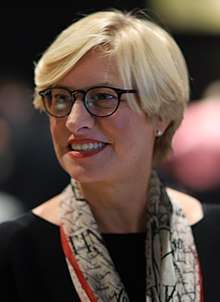 |
Undersecretaries: Gioacchino Alfano (AP)[lower-alpha 8] Domenico Rossi (CD) | |||||
 |
Before January 2018: Independent |
Deputy Ministers: Luigi Casero (AP)[lower-alpha 8] Enrico Morando (PD) Undersecretaries: Pier Paolo Baretta (PD) Paola De Micheli (PD) (until 23 Sep. 2017) | ||||
 |
Before March 2018: Independent |
Deputy Ministers: Teresa Bellanova (PD) Undersecretaries: Antonio Gentile (AP)[lower-alpha 8] Antonello Giacomelli (PD) Ivan Scalfarotto (PD) | ||||
 |
Deputy Ministers: Andrea Olivero (DemoS) Undersecretaries: Giuseppe Castiglione (AP)[lower-alpha 8] | |||||
 |
(ad interim) |
|||||
.jpg) |
Undersecretaries: Barbara Degani (AP)[lower-alpha 8] Silvia Velo (PD) | |||||
 |
Deputy Ministers: Riccardo Nencini (PSI) Undersecretaries: Umberto Del Basso De Caro (PD) Simona Vicari (AP)[lower-alpha 8] (until 25 May 2017) | |||||
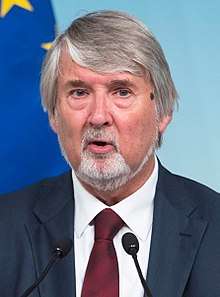 |
Undersecretaries: Franca Biondelli (PD) Luigi Bobba (PD) Massimo Cassano (AP)[lower-alpha 8] (until 25 July 2017) | |||||
 |
Undersecretaries: Vito De Filippo (PD) Gabriele Toccafondi (AP)[lower-alpha 8] Angela D'Onghia (Ind.) (until 4 Dec. 2017) | |||||
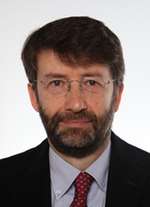 |
Undersecretaries: Dorina Bianchi (AP)[lower-alpha 8] Ilaria Borletti Buitoni (PD) Antimo Cesaro (CI) | |||||
 |
Before 18 March 2017: New Centre-Right |
Undersecretaries: Davide Faraone (PD) | ||||
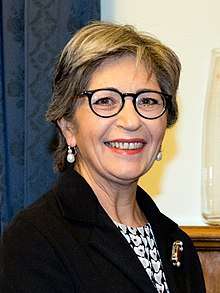 |
(without portfolio) |
|||||
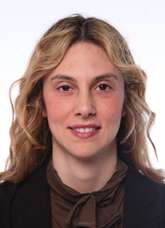 |
(without portfolio) |
|||||
 |
(without portfolio) |
Before 18 March 2017: New Centre-Right |
Undersecretaries: Gianclaudio Bressa (PD) (until 26 July 2017) | |||
 |
(without portfolio) |
|||||
 |
(without portfolio) |
|||||
 |
— | |||||
- With delegation to the implementation of the Government program, equal opportunities and independent administrative authorities.
- With delegation to the European policies.
- With delegation to information and publishing.
- Delegated authority for the security of the Republic.
- With delegation to the coordination of public policies in the economic, social, and scientific research fields.
- With delegation to the earthquakes of central Italy in 2016 and 2017.
- before 25 February 2017: PD
- before 18 March 2017: NCD
- Succeeded by Paolo Gentiloni, interim minister from 27 March 2018 to 1 June 2018
References
- "New Italian PM Gentiloni sworn in". BBC. 12 December 2016. Retrieved 15 October 2019.
- "Italy unveils new government similar to outgoing Renzi cabinet". France 24. 13 December 2016. Retrieved 15 October 2019.
- "L'ascesa di Paolo Gentiloni, dalla Margherita alla Farnesina" [Paolo Gentiloni's rise: from the Daisy to the Farnesina]. La Repubblica (in Italian). Rome: Gruppo Editoriale L’Espresso. 31 October 2014. Retrieved 20 February 2015.
- "Il governo Gentiloni ha giurato, ministri confermati tranne Giannini. Alfano agli Esteri. Minniti all'Interno. Boschi sottosegretario". Repubblica.it. 12 December 2016.
- "Governo Gentiloni, il ministro scelto da Mattarella: "Stessa maggioranza, gli altri non ci stanno". Lunedì la squadra". Il Fatto Quotidiano. 11 December 2016.
- "Governo, Denis Verdini si sfila: "No fiducia a governo fotocopia"". Corriere della Sera. 12 December 2016.
- "XVII Legislatura - XVII Legislatura - Lavori - Resoconti Assemblea - Dettaglio sedute". www.camera.it (in Italian). Retrieved 1 August 2019.
- "Legislatura 17ª - Aula - Resoconto stenografico della seduta n. 734 del 14/12/2016". www.senato.it (in Italian). Retrieved 1 August 2019.
- Martina resigned as Minister when he was appointed acting Secretary of the Democratic Party.
- Costa resigned due to contrasts with the Prime Minister. He often criticized Gentiloni's views and ideas, especially regarding immigration and birthright citizenship.
